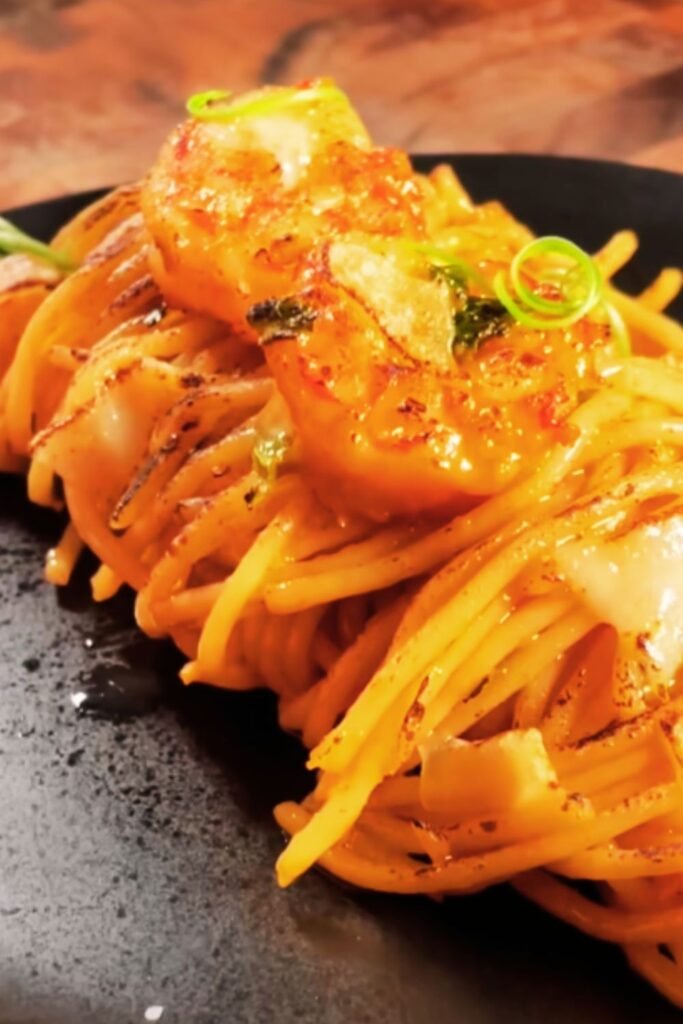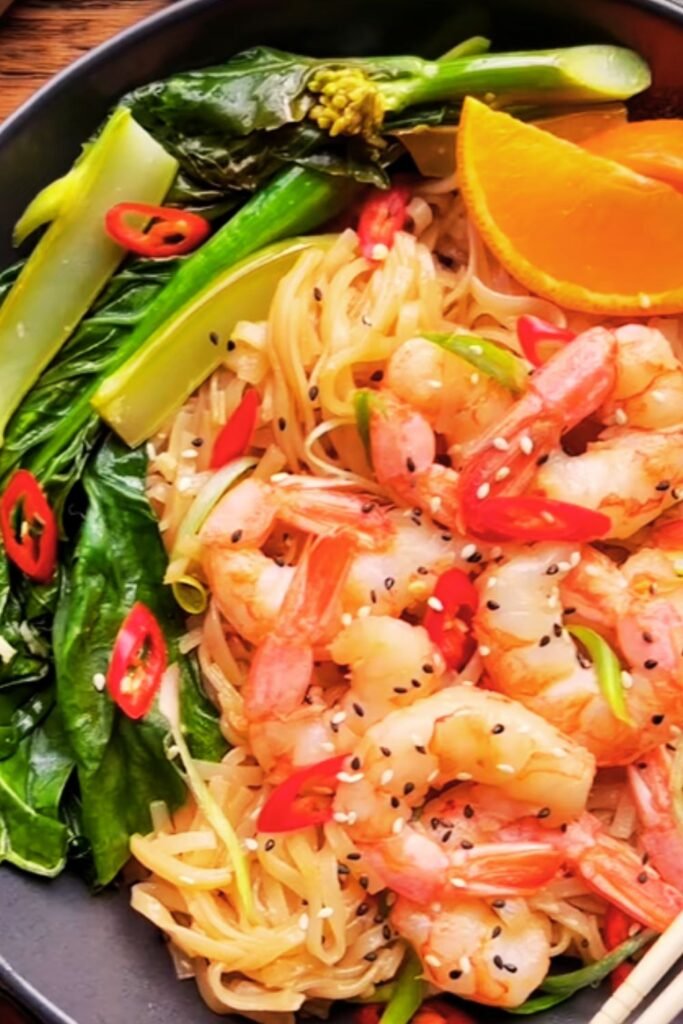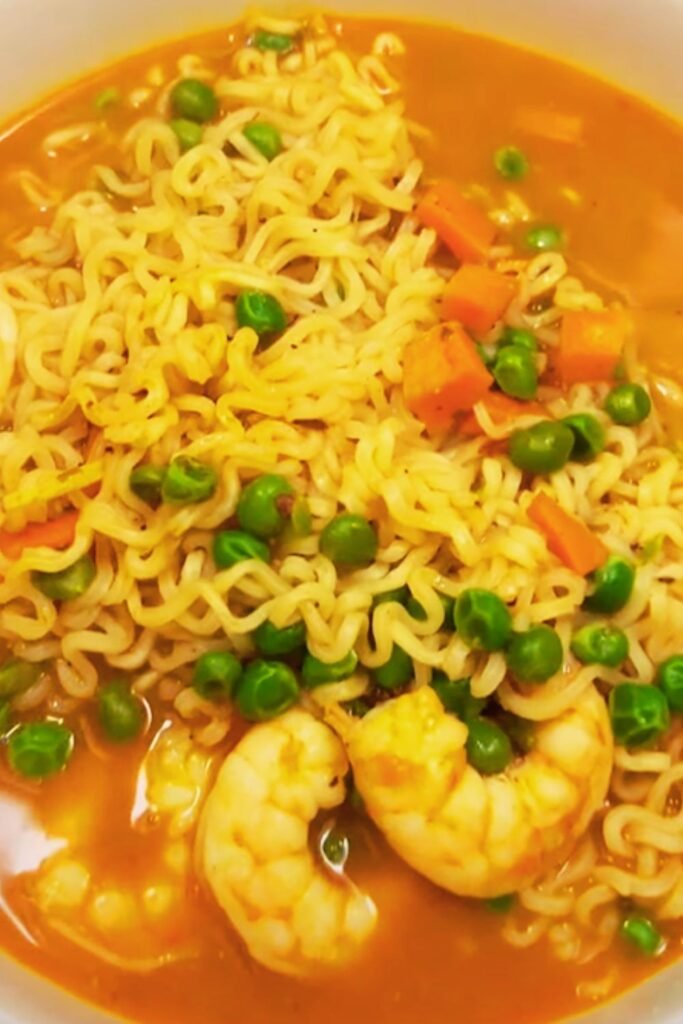When I first discovered the magic of combining perfectly seasoned shrimp with slurp-worthy noodles in a spicy, aromatic broth, my weeknight dinner game changed forever. These spicy shrimp and noodle bowls aren’t just a meal – they’re an experience that transforms your kitchen into a bustling Asian street food stall, complete with steam rising from the bowl and flavors that dance on your tongue.
I’ve spent countless evenings perfecting this recipe, tweaking the spice levels, experimenting with different noodle types, and discovering the perfect balance of heat, umami, and freshness. What started as my attempt to recreate a dish from my favorite ramen shop has evolved into something uniquely mine – and now yours.
Understanding the Foundation: Key Components Defined
Umami: The fifth taste that creates depth and savory richness, achieved through ingredients like soy sauce, miso paste, and fish sauce
Mirin: A sweet Japanese rice wine used for cooking that adds subtle sweetness and helps tenderize proteins
Gochujang: Korean fermented chili paste that provides complex heat with a hint of sweetness and deep umami flavor
Dashi: A Japanese soup stock made from kombu seaweed and bonito flakes, forming the backbone of many Asian broths
Sriracha: Thai-style hot sauce that brings bright, garlicky heat without overwhelming other flavors
Rice Noodles: Gluten-free noodles made from rice flour that absorb flavors beautifully while maintaining their texture
Shiitake Mushrooms: Meaty mushrooms that contribute earthy depth and substantial texture to the dish
Why These Bowls Will Revolutionize Your Dinner Routine
I discovered that spicy shrimp and noodle bowls solve multiple dinner dilemmas simultaneously. They’re quick enough for busy weeknights yet impressive enough for entertaining. The customizable nature means everyone at my table can adjust their heat level, and the one-bowl format makes cleanup a breeze.
The protein-packed shrimp cooks in minutes, while the aromatic broth can be prepared ahead of time. I’ve found that having this recipe in my repertoire means I’m never more than 20 minutes away from a restaurant-quality meal that costs a fraction of dining out.
Essential Ingredients Breakdown

The Protein Foundation
- Large shrimp (1.5 pounds): I prefer 16-20 count shrimp, peeled and deveined
- Marinade components: Soy sauce, rice vinegar, and cornstarch for tender, flavorful shrimp
Building the Spicy Broth Base
- Chicken or vegetable stock (6 cups): Forms the liquid foundation
- Gochujang (3 tablespoons): Provides the signature Korean heat
- Sriracha (2 tablespoons): Adds bright, garlicky spice
- Soy sauce (¼ cup): Creates umami depth
- Rice vinegar (2 tablespoons): Balances richness with acidity
- Fresh ginger (2 inches, minced): Adds warming aromatics
- Garlic (4 cloves, minced): Essential for flavor foundation
Noodle Selection Guide
- Rice noodles: My go-to for gluten-free guests
- Ramen noodles: Classic choice with perfect texture
- Udon noodles: Thick and chewy for heartier appetites
- Soba noodles: Nutty buckwheat flavor adds complexity
Fresh Finishing Elements
- Scallions (4 stalks): Bright onion flavor and color contrast
- Cilantro (½ cup): Fresh herbaceous notes
- Lime wedges: Essential citrus brightness
- Bean sprouts (1 cup): Crispy texture contrast
- Sesame seeds: Nutty finishing touch
Step-by-Step Cooking Process
Preparing the Shrimp Marinade
I start by creating a simple yet effective marinade that ensures my shrimp stay tender and flavorful. In a medium bowl, I whisk together 2 tablespoons soy sauce, 1 tablespoon rice vinegar, and 1 teaspoon cornstarch until smooth. The cornstarch creates a light coating that helps the shrimp achieve a beautiful sear while staying juicy inside.
Add the cleaned shrimp to this mixture, tossing gently to coat each piece completely. I let them marinate for at least 15 minutes, though 30 minutes yields even better flavor penetration.
Crafting the Perfect Spicy Broth
The broth is where the magic happens, and I’ve learned that building layers of flavor is crucial. In a large pot, I heat 2 tablespoons of neutral oil over medium heat. When it shimmers, I add my minced ginger and garlic, stirring constantly for about 30 seconds until fragrant but not browned.
Next comes the gochujang – I whisk it into the aromatic oil, cooking for another minute to bloom the flavors. The paste should become glossy and fragrant. Then I gradually add the stock, whisking to ensure the gochujang dissolves completely without clumping.

I bring this mixture to a gentle boil, then reduce heat to maintain a steady simmer. At this point, I add the soy sauce, sriracha, and rice vinegar, tasting as I go. The broth should hit all the flavor notes: spicy heat from the gochujang, bright acidity from the vinegar, and deep umami from the soy sauce.
Cooking Techniques for Perfect Shrimp
The key to exceptional shrimp lies in high heat and quick cooking. I heat a large skillet or wok over high heat until it’s smoking. A thin layer of oil goes in, followed immediately by the marinated shrimp in a single layer.
I resist the urge to move them for the first 2 minutes – this allows a beautiful golden crust to form. Then I flip each shrimp and cook for another 1-2 minutes until they’re just cooked through. Overcooked shrimp become rubbery, so I watch carefully for that perfect moment when they turn pink and curl slightly.
Noodle Preparation Methods
Different noodles require different approaches, and I’ve learned to time everything perfectly:
- Rice noodles: Soak in hot water according to package directions, usually 8-10 minutes
- Fresh ramen: Boil for 2-3 minutes until just tender
- Dried ramen: Cook for 3-4 minutes, slightly less than package directions since they’ll finish in the hot broth
- Udon: Fresh takes 2-3 minutes, frozen needs 4-5 minutes of boiling
I always undercook noodles slightly since they’ll continue cooking when I add the hot broth.
Nutritional Profile and Health Benefits
| Nutrient | Per Serving | % Daily Value | Health Benefits |
|---|---|---|---|
| Protein | 28g | 56% | Muscle maintenance and satiety |
| Calories | 420 | 21% | Balanced energy for active lifestyles |
| Sodium | 1,200mg | 52% | Supports electrolyte balance |
| Vitamin C | 15mg | 17% | Immune system support |
| Iron | 3.2mg | 18% | Oxygen transport and energy |
| Selenium | 22mcg | 40% | Antioxidant protection |
| Omega-3 | 0.3g | 19% | Heart and brain health |
| Fiber | 3g | 12% | Digestive health support |
The shrimp in these bowls provides high-quality, lean protein with all essential amino acids. I appreciate that each serving delivers nearly half the daily protein requirement while remaining relatively low in calories. The selenium content is particularly impressive – this mineral acts as a powerful antioxidant and supports thyroid function.
Spice Level Customization Guide
| Heat Level | Gochujang Amount | Sriracha Amount | Additional Spices | Scoville Range |
|---|---|---|---|---|
| Mild | 1 tablespoon | 1 teaspoon | Sweet paprika | 1,000-2,500 |
| Medium | 2 tablespoons | 1 tablespoon | Red pepper flakes | 2,500-5,000 |
| Hot | 3 tablespoons | 2 tablespoons | Fresh chilies | 5,000-10,000 |
| Extra Hot | 4 tablespoons | 3 tablespoons | Habanero paste | 10,000-25,000 |
| Fire | 5 tablespoons | ¼ cup | Ghost pepper flakes | 25,000+ |
I’ve found that the beauty of this recipe lies in its adaptability. When I’m cooking for a crowd with varying spice tolerances, I prepare the base broth at medium heat and offer additional sriracha and chili oil on the side. This way, everyone can customize their bowl to their preference.
Ingredient Substitutions and Variations
Protein Alternatives
When shrimp isn’t available or preferred, I’ve successfully used:
- Chicken thighs: Cut into bite-sized pieces, marinated similarly
- Tofu: Extra-firm, cubed and pan-fried until golden
- Salmon: Skin-on fillets, seared and flaked into the bowl
- Pork belly: Thinly sliced and quickly seared
Dietary Modifications
For my gluten-free friends, I ensure all sauces are certified gluten-free and use rice noodles or shirataki noodles. The dish naturally accommodates this restriction beautifully.
Vegetarian versions work wonderfully with mushroom or vegetable stock as the base. I add extra shiitake mushrooms and sometimes include cubed firm tofu for protein.

Assembly and Presentation Techniques
The visual appeal of these bowls is almost as important as their flavor. I’ve developed a system that ensures each bowl looks restaurant-worthy:
First, I warm my serving bowls – this keeps the noodles from cooling too quickly. I place the cooked noodles in the bottom, creating a small nest in the center. The hot broth goes in next, poured around the noodles to maintain their shape.
I arrange the cooked shrimp on one side of the bowl, their pink color creating beautiful contrast. Fresh vegetables get arranged in small piles around the bowl: bean sprouts for crunch, sliced scallions for color, and cilantro leaves for freshness.
The final touch is a lime wedge perched on the rim and a sprinkle of sesame seeds over everything. The result is a bowl that’s Instagram-worthy before it’s devoured.
Storage and Meal Prep Strategies
These bowls lend themselves beautifully to meal preparation, though I’ve learned some crucial techniques through trial and error. The components should be stored separately to maintain optimal texture and flavor.
Broth Storage: The spicy broth keeps in the refrigerator for up to 5 days and actually improves in flavor as the spices meld. I make large batches and freeze portions in ice cube trays for quick single servings.
Cooked Shrimp: Best used within 2 days of cooking. I slightly undercook them for meal prep since they’ll heat through when the hot broth is added.
Noodles: These are best cooked fresh, but I can prepare them up to 2 hours ahead and toss with a little oil to prevent sticking.
Fresh Elements: I prep these the night before, storing each component in separate containers to maintain crispness.
Troubleshooting Common Issues
Broth Too Salty
This happens when I get heavy-handed with the soy sauce. My fix is adding a splash of rice vinegar and a pinch of sugar to balance the flavors. If it’s severely over-salted, I dilute with additional unsalted stock.
Shrimp Overcooked
Rubbery shrimp are disappointing but preventable. I always remove them from heat the moment they turn pink and curl. If they do overcook, I chop them and use as a topping rather than the main protein component.
Noodles Mushy
This usually results from overcooking or letting them sit too long in the hot broth. I combat this by slightly undercooking the noodles and serving immediately after assembly.
Heat Level Issues
Too spicy: Add coconut milk or cream to mellow the heat Not spicy enough: Mix additional gochujang with a little hot broth before stirring into the bowl
Serving Suggestions and Pairings
These bowls shine as complete meals, but I often enhance the experience with complementary sides. A simple cucumber salad with rice vinegar dressing provides cooling contrast to the spicy broth. Steamed edamame makes an excellent starter, offering protein and a different texture.
For beverages, I find that iced green tea or jasmine tea perfectly complements the bold flavors without competing. Coconut water also works wonderfully, especially for those who want to temper the spice level.
When entertaining, I set up a “noodle bowl bar” with various toppings and let guests customize their creations. This interactive element always proves popular and accommodates different dietary preferences and spice tolerances.
Advanced Techniques and Pro Tips
After making these bowls hundreds of times, I’ve discovered several techniques that elevate them from good to exceptional:
Blooming the Spices: I always bloom my gochujang and garlic in oil before adding liquid. This technique intensifies their flavors and creates a more complex, layered taste.
Temperature Control: The broth should be steaming hot when served, but not boiling vigorously. This ensures the noodles don’t overcook in the bowl while maintaining the perfect serving temperature.
Umami Layering: I build umami through multiple sources rather than relying on just soy sauce. Fish sauce, mushroom powder, or a splash of oyster sauce can add incredible depth.
Texture Contrast: Every bite should offer different textures. The tender shrimp, chewy noodles, crisp vegetables, and smooth broth create a symphony of mouthfeel that keeps each spoonful interesting.
Seasonal Adaptations
I adapt these bowls throughout the year to take advantage of seasonal ingredients and match the weather:
Spring: Fresh peas, asparagus tips, and baby bok choy add vibrant color and tender crunch Summer: I increase the lime juice and add fresh herbs like Thai basil or mint for cooling effect Fall: Roasted squash cubes and shiitake mushrooms provide heartier, earthier flavors Winter: I boost the ginger and add warming spices like white pepper for extra heat
Cultural Context and Inspiration
While my version draws inspiration from various Asian cuisines, I’m careful to approach it with respect and understanding. The Korean gochujang provides the primary heat profile, while Japanese dashi techniques inform the broth construction. Thai sriracha adds brightness, and Chinese stir-frying methods guide the shrimp preparation.
This fusion approach reflects how food naturally evolves as it travels and adapts to new kitchens and palates. My goal is always to honor the traditional techniques while creating something delicious and accessible in my home kitchen.
Q&A Section
Q: Can I make this recipe dairy-free? My version is naturally dairy-free, using only plant-based and seafood ingredients. I avoid any cream or butter, relying on the natural richness of the broth and properly cooked shrimp for satisfaction.
Q: How spicy is this dish compared to restaurant versions? I’d rate my standard recipe as medium heat – definitely noticeable but not overwhelming. Most people find it pleasantly spicy with a building warmth rather than immediate fire. The beauty is that you can easily adjust the heat level to your preference.
Q: What’s the best way to devein shrimp quickly? I use a small paring knife to make a shallow cut along the back of the shrimp, then rinse under cold water to remove the vein. For speed, I buy pre-cleaned shrimp when my budget allows, though I prefer the flavor of shrimp I clean myself.
Q: Can I use frozen shrimp for this recipe? Absolutely! I thaw frozen shrimp completely and pat them dry before marinating. The key is removing excess moisture so they sear properly rather than steaming in the pan.
Q: How long does the assembled bowl stay good? I recommend eating these immediately after assembly for the best texture and temperature experience. However, leftover components can be refrigerated separately and reassembled within 2-3 days.
Q: What if I can’t find gochujang? While gochujang provides a unique flavor profile, I can substitute with a mixture of sriracha, miso paste, and a touch of brown sugar. The result won’t be identical but will still be delicious.
Q: Is this recipe suitable for meal prep? Yes, with proper component separation! I prep the broth, cook the shrimp, and prepare vegetables ahead of time. I cook fresh noodles each time for the best texture, though they can be par-cooked and stored for up to 2 days.
Q: How do I prevent the noodles from getting soggy? The key is timing and temperature. I slightly undercook the noodles, drain them well, and add them to hot (not boiling) broth just before serving. Never let cooked noodles sit in broth for extended periods.
Q: Can I make a vegetarian version? Definitely! I substitute the shrimp with cubed firm tofu or king oyster mushrooms, use vegetable stock instead of chicken stock, and add extra vegetables for substance. The flavors remain complex and satisfying.
Q: What’s the secret to getting restaurant-quality flavor at home? The magic lies in layering flavors and using high-quality ingredients. I don’t skip the marinating step for the protein, I build the broth gradually, and I finish with fresh elements that add brightness and contrast to the rich, spicy base.
These spicy shrimp and noodle bowls have become more than just a recipe in my kitchen – they’re a reliable source of comfort, excitement, and satisfaction. Whether I’m cooking for family on a busy Tuesday or impressing friends at a dinner party, these bowls deliver every single time. The combination of customizable heat levels, quick cooking time, and restaurant-quality results makes them an invaluable addition to any home cook’s repertoire.
I hope this detailed guide empowers you to create your own perfect version of these bowls, adapting the flavors and heat levels to suit your preferences while mastering the techniques that ensure success every time you cook them.